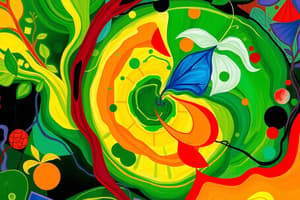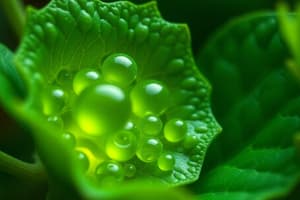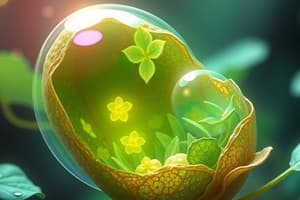Podcast
Questions and Answers
What is the primary role of chlorophyll in photosynthesis?
What is the primary role of chlorophyll in photosynthesis?
- To absorb light energy. (correct)
- To convert carbon dioxide into oxygen.
- To facilitate the Calvin cycle in the stroma.
- To transport water from the roots to the leaves.
During the light-dependent reactions of photosynthesis, what process directly leads to the release of oxygen?
During the light-dependent reactions of photosynthesis, what process directly leads to the release of oxygen?
- The splitting of water molecules (photolysis). (correct)
- The reduction of carbon dioxide to form glucose.
- The excitation of electrons by chlorophyll.
- The generation of ATP through chemiosmosis.
How does increasing carbon dioxide concentration typically affect the rate of photosynthesis, assuming other factors are not limiting?
How does increasing carbon dioxide concentration typically affect the rate of photosynthesis, assuming other factors are not limiting?
- It decreases the rate due to enzyme inhibition.
- It enhances the rate up to a saturation point. (correct)
- It has no effect on the rate.
- It reduces the amount of light absorbed by chlorophyll.
Why can high temperatures reduce or stop photosynthesis?
Why can high temperatures reduce or stop photosynthesis?
Which of the following macronutrients is most essential for protein synthesis, nucleic acids, and chlorophyll production in plants?
Which of the following macronutrients is most essential for protein synthesis, nucleic acids, and chlorophyll production in plants?
Which micronutrient is involved in water splitting during photosynthesis?
Which micronutrient is involved in water splitting during photosynthesis?
If a plant's leaves show yellowing between the veins (interveinal chlorosis), what nutrient is most likely deficient?
If a plant's leaves show yellowing between the veins (interveinal chlorosis), what nutrient is most likely deficient?
Which of the following best describes the relationship between light-dependent and light-independent reactions in photosynthesis?
Which of the following best describes the relationship between light-dependent and light-independent reactions in photosynthesis?
How does temperature affect photosynthesis, and what is the underlying reason for this effect?
How does temperature affect photosynthesis, and what is the underlying reason for this effect?
Flashcards
Photosynthesis
Photosynthesis
The process where plants use sunlight to convert carbon dioxide and water into glucose and oxygen.
Chloroplasts
Chloroplasts
Organelles in plant cells where photosynthesis takes place; contain chlorophyll.
Chlorophyll
Chlorophyll
A pigment in chloroplasts that absorbs sunlight, crucial for photosynthesis.
Light-Dependent Reactions
Light-Dependent Reactions
Signup and view all the flashcards
Light-Independent Reactions (Calvin Cycle)
Light-Independent Reactions (Calvin Cycle)
Signup and view all the flashcards
Photolysis
Photolysis
Signup and view all the flashcards
ATP (Adenosine Triphosphate)
ATP (Adenosine Triphosphate)
Signup and view all the flashcards
Factors Affecting Photosynthesis
Factors Affecting Photosynthesis
Signup and view all the flashcards
Plant Nutrients
Plant Nutrients
Signup and view all the flashcards
Macronutrients
Macronutrients
Signup and view all the flashcards
Micronutrients
Micronutrients
Signup and view all the flashcards
Nitrogen (N)
Nitrogen (N)
Signup and view all the flashcards
Phosphorus (P)
Phosphorus (P)
Signup and view all the flashcards
Potassium (K)
Potassium (K)
Signup and view all the flashcards
Mycorrhizae
Mycorrhizae
Signup and view all the flashcards
Study Notes
- Plants use sunlight to synthesize foods from carbon dioxide and water through photosynthesis
- Chlorophyll is involved in photosynthesis
- Photosynthesis occurs in the chloroplasts
- Photosynthesis is vital for plant nutrition and life on Earth by providing energy and oxygen
Photosynthesis Overview
- Photosynthesis converts water and carbon dioxide into glucose (sugar) and oxygen using light energy
- This process is essential for plant nutrition, as plants cannot consume food like animals
- Light energy is used to create chemical energy
- Photosynthesis occurs in two main stages: light-dependent reactions and light-independent reactions (Calvin cycle)
- The general equation for photosynthesis is 6CO2 + 6H2O + Light Energy → C6H12O6 + 6O2
Chloroplasts and Chlorophyll
- Photosynthesis occurs in chloroplasts
- Chloroplasts contain chlorophyll, which absorbs sunlight
- Chlorophyll is primarily in the thylakoid membranes inside the chloroplasts
- Different types of chlorophyll exist, each absorbing light at slightly different wavelengths
- Chlorophyll a and chlorophyll b are the most common types in plants
Light-Dependent Reactions
- Light-dependent reactions occur in the thylakoid membranes of the chloroplasts
- Light energy is absorbed by chlorophyll, exciting electrons
- Energized electrons move through an electron transport chain, generating ATP (adenosine triphosphate) and NADPH
- Water molecules are split (photolysis) to replace electrons, releasing oxygen as a byproduct
- ATP and NADPH are essential for the Calvin cycle
Light-Independent Reactions (Calvin Cycle)
- The Calvin cycle takes place in the stroma of the chloroplasts
- Carbon dioxide is captured and converted into glucose using ATP and NADPH from the light-dependent reactions
- The cycle involves carbon fixation, reduction, and regeneration of the starting molecule (RuBP)
- Glucose produced is used by the plant as an energy source
- Glucose can be converted into other organic molecules like starch and cellulose
Factors Affecting Photosynthesis
- Environmental factors influence the rate of photosynthesis
- Light intensity, carbon dioxide concentration, and temperature are key factors
Light Intensity
- The rate of photosynthesis increases with light intensity up to a certain point
- Beyond the saturation point, the rate plateaus or decreases due to other limiting factors
- Insufficient light limits the rate of photosynthesis
Carbon Dioxide Concentration
- Increasing carbon dioxide concentration enhances the rate of photosynthesis
- At high concentrations, the rate plateaus due to enzyme saturation
- Limited carbon dioxide restricts the Calvin cycle
Temperature
- Photosynthesis involves enzymes, making it temperature-sensitive
- The rate increases with temperature to an optimum level
- High temperatures can denature enzymes, reducing the rate or stopping photosynthesis
- Low temperatures reduce the rate of enzymatic reactions
Plant Nutrition
- Plant nutrition involves uptake and use of essential elements for growth and development
- Plants obtain nutrients from the soil through their roots
- Macronutrients and micronutrients are vital for plan health
Macronutrients
- Macronutrients are required in larger quantities
- Nitrogen (N), phosphorus (P), and potassium (K) are primary macronutrients
- Nitrogen is essential for protein synthesis, nucleic acids, and chlorophyll
- Phosphorus is needed for ATP, nucleic acids, and phospholipids
- Potassium regulates water balance, enzyme activation, and nutrient transport
- Calcium (Ca), magnesium (Mg), and sulfur (S) are secondary macronutrients
- Calcium is essential for cell wall structure and enzyme regulation
- Magnesium is a component of chlorophyll and activates enzymes
- Sulfur is part of amino acids and proteins
Micronutrients
- Micronutrients are required in small quantities
- Iron (Fe), manganese (Mn), zinc (Zn), copper (Cu), boron (B), molybdenum (Mo), and chlorine (Cl) are micronutrients
- Iron is involved in chlorophyll synthesis and electron transport
- Manganese activates enzymes and assists in water splitting during photosynthesis
- Zinc is a component of enzymes and regulates growth hormones
- Copper is a part of enzymes involved in redox reactions
- Boron is essential for cell wall synthesis and sugar transport
- Molybdenum is required for nitrogen fixation
- Chlorine is involved in osmosis and ion balance
Nutrient Uptake
- Plants get nutrients from the soil solution
- Nutrient uptake occurs through root hairs, increasing the surface area for absorption
- Active and passive transport mechanisms are involved
- Mycorrhizae, a symbiotic relationship between fungi and plant roots, enhances nutrient uptake
- The fungi extend the root’s reach, increasing absorption of water and nutrients, especially phosphorus
Nutrient Deficiencies
- Nutrient deficiencies affect plant growth and development
- Symptoms vary depending on the nutrient and plant species
- Nitrogen deficiency shows yellowing of leaves (chlorosis), starting with older leaves
- Phosphorus deficiency results in stunted growth and purplish leaves
- Potassium deficiency causes yellowing and spotting of leaves, particularly at the margins
- Iron deficiency leads to interveinal chlorosis, where the veins remain green while the leaf tissue yellows
- Nutrient deficiencies can be addressed through soil testing and fertilizer application
Studying That Suits You
Use AI to generate personalized quizzes and flashcards to suit your learning preferences.




